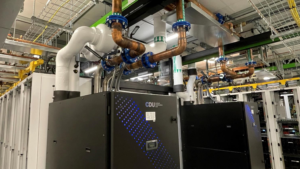As artificial intelligence continues to surge, the data centers powering this digital revolution are being pushed to their limits, not only in terms of computing, but sustainability.
I had the chance to speak with Bruno Berti, SVP Global Product Management and NTT Global Data Centers, about this topic at the recent Upgrade 2025 conference in San Francisco, CA.
Berti shared a behind-the-scenes look with me at how the company is meeting these challenges head-on by rethinking how data centers consume energy and stay cool.
“Traditionally, we cooled equipment by blowing cold air through buildings,” explained Berti. “But with the next wave of AI hardware, like what’s coming from NVIDIA, we’re moving to direct liquid cooling at the chip level. That shift is a game changer.”
Instead of relying on massive air handlers, NTT is now piping cooled liquid directly over the server chips using cold plates with copper tubing.
The result is a closed-loop system that not only dissipates heat more effectively, but also recycles the water to avoid waste, which is an important aspect of the company’s sustainability mission.
“We don’t waste any water in our cooling technology,” said Berti. “It’s a closed loop system. We take hot water, cool it again, and bring it back—over and over. That’s part of our design from a sustainability perspective.”
This approach isn’t just greener; it’s dramatically more efficient. As Berti explained, racks that once consumed the power equivalent of three homes can now pull as much as 150 kilowatts per rack, roughly 50 times more than previous generations.
That density means data centers can be smaller but much more powerful, which is critical as space and electricity become scarce in urban hubs.
The innovation doesn’t stop with chip-level cooling. NTT is also exploring how to reuse the heat generated in its facilities. “Instead of releasing that heat into the environment,” Berti said, “we’re using it to heat buildings in the community through closed-loop systems. We’re doing this in places like Berlin and Frankfurt and expanding the concept to other regions.”
Another standout sustainability initiative involves rethinking backup power sources. While diesel generators have long been the norm, NTT is piloting the use of hydrogenated vegetable oil (HVO), which is a clean-burning fuel derived from recycled cooking oil.
“It’s actually better than traditional diesel,” Berti noted, “and it’s good for the environment and good for recycling.”
And as power grids in places like Dallas, TX strain under the demand of rapid data center growth, sustainability is certainly a real concern. That’s why rural areas such as San Angelo, Texas, for example, are now fast on their way to becoming new tech hubs due to their available electricity.
Berti shared that nuclear energy, and advanced modular reactors are also once again entering the mainstream conversation, offering promising new options for clean, scalable power generation.
In short, it was clear from my conversation with Berti that NTT sees what is happening in the world, and it isn’t just building data centers; it’s redefining what they can be. “We’re not chasing trends,” said Berti. “We’re building solutions for AI companies, traditional cloud providers, and enterprises alike—solving real problems across the board.”
As AI drives up the demand for power and performance, NTT’s thoughtful approach to energy, cooling and environmental impact offers a blueprint for a more sustainable digital future.

